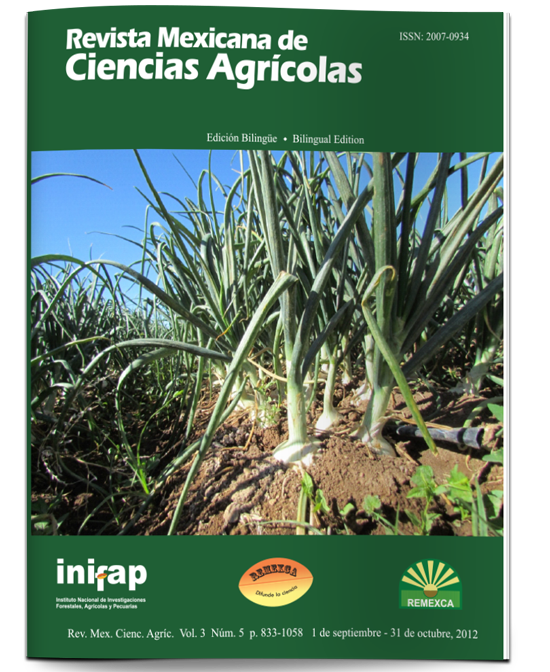Fruit nutrient composition and removal by ‘Haden’ and ‘Tommy Atkins’ mangos fruits under forced production
DOI:
https://doi.org/10.29312/remexca.v3i5.1384Keywords:
Mangifera indica L., embryo, epidermis, pulp, testaAbstract
To improve the management of mango nutrition and maintain soil fertility it is necessary to know the nutrient composition of the fruit as well as the amount of nutrients removed by the crop planting . This study was carried out in 2009 with the cvs. Haden and Tommy Atkins under forced production in the Valle de Apatzingán, Michoacán, Mexico, with the aims of: i) determining the nutrient composition of the fruit's tissues (epidermis, pulp, testa and embryo); and ii) quantifying the amount of nutrients removed by the crop of both mango cultivars. Two commercial ‘Haden’ mango orchards were chosen, along with two ‘Tommy Atkins’ orchards, with similar irrigation schemes and soils (Vertisol). In each orchard five trees were chosen and harvested two fruit per tree at physiological maturity. Fruit were separated in their tissues and the concentrations of N, P, K, Ca, Mg, S, Fe, Cu, Mn, Zn, and B were determined in the dry matter. The nutrient composition of the fruit's tissues showed variations in each cultivar. The epidermis and the embryo presented the greatest concentrations of nutrients. The amounts of nutrients removed varied with the tissue; the highest values were for the pulp and epidermis, and the lowest were in the testa. The amount of nutrients removed per ton of fresh fruit was similar in both mango cultivars, except for Mn, which was removed in greater amounts by fruit of ‘Haden’. The nutritional removal intervals for ‘Haden’ and ‘Tommy Atkins’ were (kg⋅t-1 fresh fruit): N (1.03-1.11), P (0.22-0.24), K (1.88-2.14), Ca (0.21-0.31), Mg (0.14-0.15), S (0.28-0.33); (g⋅t-1 fresh fruit): Fe (3.5-3.8), Cu (1.0-1.1), Mn (3.2-4.8), Zn (2.0-2.8), and B (1.5-1.6).
Downloads
Downloads
Published
How to Cite
Issue
Section
License
The authors who publish in Revista Mexicana de Ciencias Agrícolas accept the following conditions:
In accordance with copyright laws, Revista Mexicana de Ciencias Agrícolas recognizes and respects the authors’ moral right and ownership of property rights which will be transferred to the journal for dissemination in open access. Invariably, all the authors have to sign a letter of transfer of property rights and of originality of the article to Instituto Nacional de Investigaciones Forestales, Agrícolas y Pecuarias (INIFAP) [National Institute of Forestry, Agricultural and Livestock Research]. The author(s) must pay a fee for the reception of articles before proceeding to editorial review.
All the texts published by Revista Mexicana de Ciencias Agrícolas —with no exception— are distributed under a Creative Commons License Attribution-NonCommercial 4.0 International (CC BY-NC 4.0), which allows third parties to use the publication as long as the work’s authorship and its first publication in this journal are mentioned.
The author(s) can enter into independent and additional contractual agreements for the nonexclusive distribution of the version of the article published in Revista Mexicana de Ciencias Agrícolas (for example include it into an institutional repository or publish it in a book) as long as it is clearly and explicitly indicated that the work was published for the first time in Revista Mexicana de Ciencias Agrícolas.
For all the above, the authors shall send the Letter-transfer of Property Rights for the first publication duly filled in and signed by the author(s). This form must be sent as a PDF file to: revista_atm@yahoo.com.mx; cienciasagricola@inifap.gob.mx; remexca2017@gmail.
This work is licensed under a Creative Commons Attribution-Noncommercial 4.0 International license.



